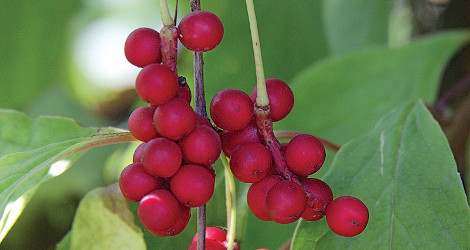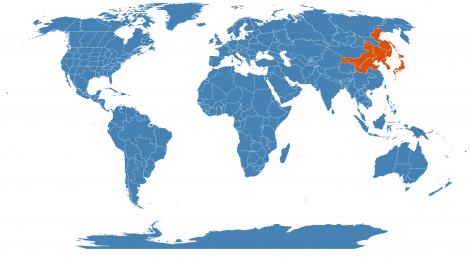Accession Data:
Schisandra chinensis (Turcz.) Baill.
- Common Name: Magnolia Vine
- Family: Schisandraceae Blume
- Description:
- Uses: One of the 50 Fundamental Herbs in Traditional Chinese Medicine known as Wu Wei Zi. Also a very traditional Ayurvedic plant. This herbs assists in respiratory ailments- coughing, mucous, asthma etc.
One significant trait it is has is to hold fluid within the body. This assists in leakage of sperm, urinary frequency and vaginal discharge.
The berries are very helpful in respiratory ailments like: asthma, bronchitis, chronic coughing, and strengthening the lungs. These berries can also help in the digestive system by acting as a tonic for the liver, flushing the kidneys, relieving chronic diarrhea, aiding in urinary disorders, and reducing inflammation of the liver. The berries have especially been studied by scientists in their properties to alleviate hepatitis. The berries have been found to have Glutathione peroxidase, an enzyme that breaks down free radicals which would otherwise damage the liver.
This fruit also contains liganans which some scientists believe reduce the risk of breast cancer. In terms of reproductive organs, the berries help with involuntary ejaculation and is considered an aphrodisiac. It may also cause contractions and induce labor.
In the Nervous system, the berries are known to help with mental disorders, memory loss and increasing neuron responses. Wu Wei Zi has been used to aid in body hydration and tranquility of the mind (nightmares, fears, insomnia).
- IMPORTANT NOTE: Plant Uses are for informational purposes only. EEB Greenhouses assume no responsibility for adverse effects from the use of any plants referred to on this site. Always seek advice from a professional before using any plant medicinally.
- USDA Zone: 4a-10b
Accession Data:
- Accession # 200700132
- Source: Forest Farm
- Accession Date: 08-25-2007
- Bench: 2304 - Temperate Asia - Low
- Currently: active - marginal
- Qty: 1 confirmed on 07-07-2025
Classification:
- Division: Magnoliophyta
- Class: Magnoliopsida
- SubClass: basal angiosperms
- Order: Austrobaileyales
- SubOrder:
- Family: Schisandraceae
- SubFamily:
- Tribe:
- SubTribe:
Flowering Data:
This accession has been observed in bloom on:| Year | Jan | Feb | Mar | Apr | May | Jun | Jul | Aug | Sep | Oct | Nov | Dec | ||||||||||||||||||||||||||||||||||||||||
|---|---|---|---|---|---|---|---|---|---|---|---|---|---|---|---|---|---|---|---|---|---|---|---|---|---|---|---|---|---|---|---|---|---|---|---|---|---|---|---|---|---|---|---|---|---|---|---|---|---|---|---|---|
| 2025 | ||||||||||||||||||||||||||||||||||||||||||||||||||||
| 2024 | ||||||||||||||||||||||||||||||||||||||||||||||||||||
| 2023 | ||||||||||||||||||||||||||||||||||||||||||||||||||||
| 2022 | ||||||||||||||||||||||||||||||||||||||||||||||||||||
| 2021 | ||||||||||||||||||||||||||||||||||||||||||||||||||||
| 2020 | ||||||||||||||||||||||||||||||||||||||||||||||||||||
| 2019 | ||||||||||||||||||||||||||||||||||||||||||||||||||||
| 2018 | ||||||||||||||||||||||||||||||||||||||||||||||||||||
| 2017 | ||||||||||||||||||||||||||||||||||||||||||||||||||||
| 2016 | ||||||||||||||||||||||||||||||||||||||||||||||||||||
| 2015 | ||||||||||||||||||||||||||||||||||||||||||||||||||||
| 2014 | ||||||||||||||||||||||||||||||||||||||||||||||||||||
| 2013 | ||||||||||||||||||||||||||||||||||||||||||||||||||||
| 2012 | ||||||||||||||||||||||||||||||||||||||||||||||||||||
| 2011 | ||||||||||||||||||||||||||||||||||||||||||||||||||||
References (internal):
- Medicinal Plants
- Medicinal Plants - Ayurveda Medicine
- Basal Angiosperms (paleodicots)
- Medicinal Plants - Traditional Chinese Medicine
- Medicinal Plants - Respiratory System
- Medicinal Plants - Digestive System
- Medicinal Plants - Urinary System
- Medicinal Plants - Immune System
- Medicinal Plants - Reproductive System
- Medicinal Plants - Nervous System
- Currently Featured Medicinal Plants
- EEB Greenhouse Holdings native to: Khabarovsk / Primorye / Sakhalin / Inner Mongolia / Manchuria / China North-Central / Japan / Korea
References (external):
- Schisandra chinensis at Wikipedia. Last accessed on Thursday, December 07, 2017.
- The Plant List (2013). Version 1.1. Accessed 26 February 2015.
- WCSP (2015). World Checklist of Selected Plant Families. Facilitated by the Royal Botanic Gardens, Kew. Accessed 26 February 2015.
- Image #00 (cropped) & #01 (original) by English: Vladimir KosolapovРусский: Владимир Косолапов (Own work) [CC BY 3.0], via Wikimedia Commons. Last accessed on Thursday, December 07, 2017.
- Schisandra chinensis . Last accessed on Thursday, March 29, 2018.
data regenerated on Mon, 07 Jul 2025 14:27:02 -0400 [bcm v4.0]
Images:

Additional images for this accession:
Click on thumbnails to enlargeCurrent Accessions in the Schisandraceae
W/C = Wild Collected = indicates flowering in past 14 days
= indicates flowering in past 14 days
 = images available for this accession
= images available for this accession
 = map available for this accession
= map available for this accession
 = accession added within past 90 days
= accession added within past 90 days

